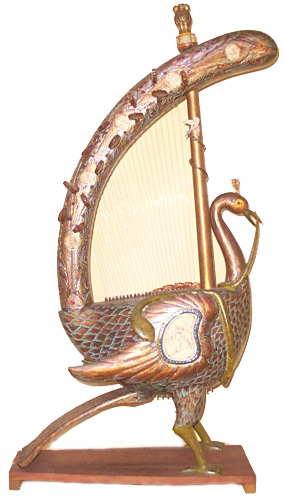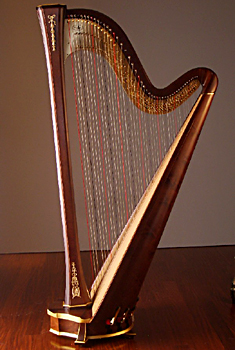Music occupies an important place in both religious and secular spheres.

Music is a fine art which is a source of joy and attraction to all beings – gods, men and beasts. “The animal, the baby and the serpent know the sweetness of music” is a well-known saying. — Pasurvetti sisurvetti vetti gaanarasam phanee
It can be heard in the houses of all – rich and poor alike. If it is in a sophisticated form in the mansion of the former, it is in a rustic way in the huts of the latter. Serpents are made to dance with their hoods expanded by the tune of the pipe of the snake-charmer. Animals like the deer are said to be caught by hunters in the forest by playing on instruments made of horns. It is common experience that the child at home is lulled to sleep by the loving mother’s song. Music was patronized by kings in ancient India and now the public are its patron. Theatres, music halls, television and radio play an important part in beginning music to the doors of all people now.
Strangely enough, there is a Vedic text which is rather unsympathetic towards musicians with the result that some who are steeped in Vedic lore are found to be averse to music. The three Vedas – Rig, Yajus and Atharva – are only chanted whereas Sama Veda, in its entirety, is sung. The apparent contradiction should be explained by saying that song as such is not decried but only singing in praise of unworthy persons with selfish motive is prohibited. Singing before Gods and Godly persons is not only permitted but even enjoined.
The institution of temples in our country has been a source of great encouragement to the various fine arts and particularly dance, drama and music. Certain occasions are set apart for the singing of songs and certain persons appointed for this purpose. Side by side with vocal music instrumental music also developed. During the procession of temple deities, playing on then pipe (nadasvaram) to the accompaniment of drum and cymbals came to be an important item. Similarly in the worship of the deities in temples, the last phase at night was singing with veena. If the Lord is lulled to sleep at night with one tune of music, Neelambari by name. He is awakened at dawn by another tune namely Bhoopala. There were minstrels known as Vandins and Vaitaalikaas in the royal courts in our country, who woke up the kings by their songs in the morning or announced the different parts of the day to remind the kings of their duties. Thus music has been and is occupying an enviable place both in our religious and secular sphere. There has been an unbroken development in the art of music from the Vedas downwards. Reference to music and musical instruments are in plenty in our Puranas, Ithihasas and Kavyas. Tamil Literature also abounds in such references are in fact there is a three-fold division of their literature as Iyal (classics) Isai (music) and Natakam (drama).
Music has been given the status of a Veda since it is known as Gandharva-veda. Sage Bharata is the first to give us a treatise on the act of dancing known as Bharta-Natya. The letters of the name Bharta are interpreted suitably to given us an idea of the nature of Natya-sastra. The letter ‘bah’ indicates that there is bhava or sentiment. ‘Ra’ that there is a raga or Music and ‘Ta’ is tala which shows that time is kept upon (Bharata – bhava, raga and tala).
There has been an equally great development in the field of musical kinds and of diverse patterns and are chiefly classified under four heads: ‘that a’ or chordophone (like veena and vipanchi), ‘avanaddha’ or membrane phone (like ghata), and ‘sushi’ or aerophone (like flute and nadasvaram).
 Frequent mention is made of these musical instruments in our poetical works both Sanskrit and Tamil. By way of illustration I shall take up the Sundarakanda of Valmiki Ramayana. Hanuman goes to Lanka in search of Sita and in the course of his wanderings enters the harem of Ravana. There he sees beautiful rakshasa damsels all asleep wearied by the nocturnal revels, each of them holding a musical instrument in her warm embrace which she should have been playing upon for the delectation of Ravana. The atodya or musical instruments mentioned therein are: veena (lute), vipanchi (lyre), vamsa (flute), kalari, madduka, mridanga, path and dindima (kinds of drums), dundubhi (kettle drum), adambara (a battle drum) and aanaka and muraja (large military drums beaten at one end).
Frequent mention is made of these musical instruments in our poetical works both Sanskrit and Tamil. By way of illustration I shall take up the Sundarakanda of Valmiki Ramayana. Hanuman goes to Lanka in search of Sita and in the course of his wanderings enters the harem of Ravana. There he sees beautiful rakshasa damsels all asleep wearied by the nocturnal revels, each of them holding a musical instrument in her warm embrace which she should have been playing upon for the delectation of Ravana. The atodya or musical instruments mentioned therein are: veena (lute), vipanchi (lyre), vamsa (flute), kalari, madduka, mridanga, path and dindima (kinds of drums), dundubhi (kettle drum), adambara (a battle drum) and aanaka and muraja (large military drums beaten at one end).
Similarly in the field of music, the sapta svaras or seven major notes have been distinguished and the pitch of each has been equated with the cry of a bird or an animal as follows. Given below are the names of svaras in Sanskrit with their Tamil equivalents in brackets.
- 1. The cry of the peacock is Shadja (kural)
- 2. The bellowing of the bull is Rishabas (tuttam)
- 3. The bleating of the sheep is Gandhara (kaikkilai)
- 4. The twitter of Krouncha bird is Madhyama (uzhai)
- 5. The cooing of the cuckoo in the spring is Panchama (ili)
- 6. The neighing of the horse is Dhaivata (vilari)
- 7. The trumpeting of the elephant is Nishada (taaram)
The realm of music is so all-pervasive that in our country Gods, Goddesses and sages are associated with it. Tumburu and Narada are wandering minstrels who ramble with veena in hand singing the glories of Lord Vishnu. Kusa and Lava sang the entire Ramayana to the accompaniment of veena. Sarasvati, the Goddess of learning, is represented as playing on the veena. Siva wields of small drum. Lord Krishna is always associated with his flute as the name Muralidhara will show. The sweet notes proceeding from His flute sent into raptures and trance all those who heard it and all those who came to hear it. Sri Periyazhvar (Vishnuchitta) has devoted a whole decade to depict the melody of flute. Rambha and Menaka, Urvasi and Tilothama, kinnaras and gandharvas all were charmed by the music. The deer stood motionless as in a picture not knowing that the grass in the mouth was falling down. The calves forgot to continue to suck milk from the udder and stood enchanted. Plants exuded streams of honey. The tiny branches with leaves and flowers of the creeper turned towards the direction from which sweet note of Sri Krishna proceeded.
The hymns of the Azhars are replete with references to music and musical instruments. Within the thirty hymns of Tiruppavai, Andal refers to songs and singing in fourteen places. The sapta svara (ezhisai) occurs repeatedly in the hymns of other Azhavars. The Lord himself is addressed as the ‘Note of the lute’ (yaazhin isaiye) by Sri Sathakopa (Nammazhvar). The bees and birds in the holy places sanctified by the presence of Bhagavan in Archa (consecrated archa-vigraha) form sing in various times which has separate names in Tamil Lieterature (e.g. Marul, Kurinji, Naivalam). The ragas Bhairavi, Ahiri, Pantuvarali, Yadukulakamboji and Sankarabaranam are respectively known in Tamil as Kausikam, Pan-Panchamam, Pan-Saadhaari, Pan-Sevvazhi, and Pan-Panchuram. All the hymns of the Azhvars have been composed that they can be set to music and in certain editions the names of pans or ragas in which they have to be sung are also given. In one song, Sri Tondaradippodi Azhvar gives the names of several musical instruments – tannumai, ekkam, maddali, yaazh, kuzhal, muzhavam – played upon by the celestial beings when they come to sing and wake up Lord Ranganatha in Srirangam.
Our acharyas also have kept up this musical-set-up of the hymns of the Azhvars. Sri Vedantadesika refers to Sri Nathamuni, the foremost acharya in the hierarchy of preceptors as the noble and broad-minded seer who gave us sweet music of the Dravida Veda (the hymns of Azhvars known as Divyaprabandha) so as to be sung keeping time. Sri Vedantadesika again describes himself as the veena that was played by Lord Venkatesa when he sang Dayasatakam – a panegyric on day. It is stated that one well versed in the art of playing veena in accordance with the science of tunes in music and keeping time is really on the path of salvation without effort.
veenaa vaadana tattvajnah sruti saastra visaaradah,
taalajnascha prasaadena moksha maargam sa gacchatti.
Sri Andal (Goda-devi) corroborates this when she concludes her Tiruppavai by saying that by music one will become recipient of all-round bliss by the Grace of Sri and Lord Narayana. We who treat the path of the Azhvars and acharyas shall also sing our way to the Lord and attain the bliss of service to Sri Vaikuntanatha here, there and everywhere.
Salutations to Azhvars and Acharyas
Source: Pudukkottai Sri A Srinivasaraghavachariar Svami











